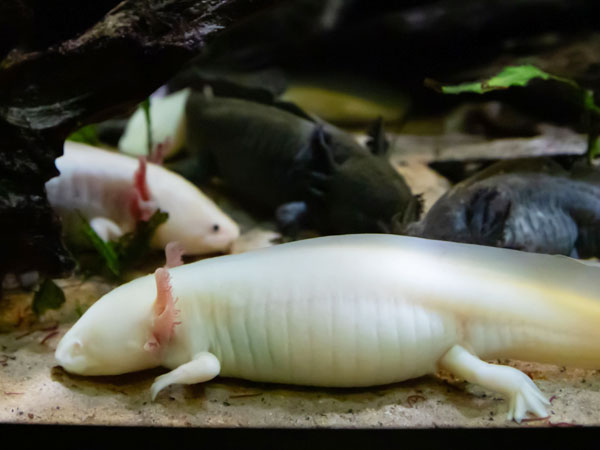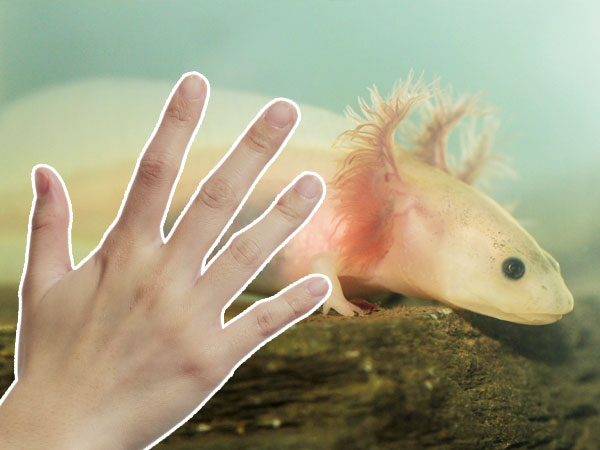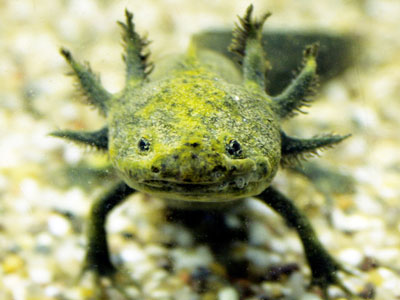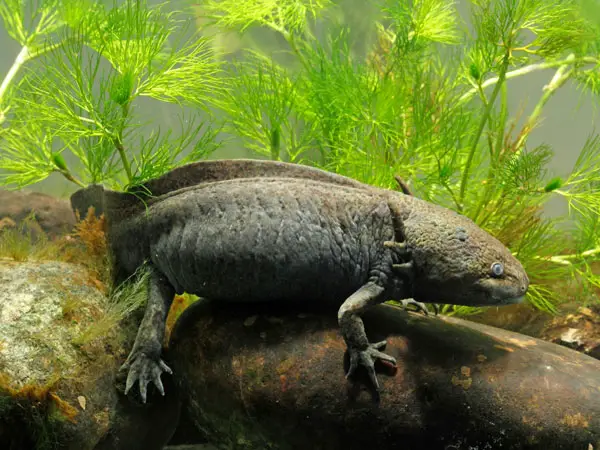If you know anything about Axolotls, you’re already familiar with the notion of weirdness. So, it’s unlikely that anything will surprise you once you get over the fish’s physiognomy, history, behavior, symbolism, etc. However, some things just might.

Such is the case with the Axolotl getting fat all of a sudden. These fish are meaty and bulky as it is. Them getting excessively fat over their natural tendency will get worrisome fast.
Today, we will discuss the reasons for Axolotls turning fat out of the blue, both the expected and the unexpected.
5 Reasons Your Axolotl Is Getting Fat
It’s normal for your Axolotl to gain weight and size as it grows. A healthy adult Axolotl will grow up to 9-12 inches and weigh approximately 10 ounces. However, some specimens can even reach 18 inches and turn into actual monsters as a result.
With that said, you should be able to tell when your Axolotl’s weight gain rate is unnatural. In this case, you have 5 potential explanations:
– Your Axolotl Didn’t Poop for a While
A healthy and happy adult Axolotl will eat approximately once every 2-3 days. That’s because their metabolism is slower than that of juveniles, so they need time to properly break down food. Juvenile Axolotls have 1 or 2 meals daily to fuel their accelerated growth rate.
Since the Axolotl eats daily, it’s normal for the animal to produce regular poop. Axolotls actually produce quite a lot of poop pretty frequently. They will produce waste daily, which should be fairly visible in the water. If the animal doesn’t poop for 2-3 days, it may be constipated.
Constipation comes with several symptoms, such as low levels of energy, visible bloating, not eating, floating, etc. This problem has several causes, including overfeeding and eating improperly sized food. If the constipation is not severe, allowing your Axolotl some time off from food will fix the problem. If not, consider placing the Axolotl in a colder-than-usual water for a couple of hours.
Make sure you monitor the amphibian to make sure that the water isn’t too cold for its wellbeing. If this doesn’t work either, contact your vet about the issue.
– Your Axolotl is Impacted
Impaction is a more drastic form of constipation resulting from a larger, more compact object blocking the intestinal tract. In most cases, compaction is the result of the Axolotl either eating large chunks of food or swallowing a piece of gravel or small rock.
This can happen due to the animal’s feeding behavior. The Axolotl doesn’t chew its food and won’t simply pick it up with its mouth. Instead, since the amphibian is low-energy in general, it uses its mouth as a suction device, catching and swallowing the prey in one go. So, it’s pretty easy for the wrong thing to go down the wrong way.
Because of compaction, the Axolotl won’t be able to poop anymore. At this point, the abdomen will inflate fast. The problem is that compaction isn’t likely to fix on its own. So, you need to contact your vet about the problem since your Axolotl may even require surgical intervention to fix the issue.
– Your Axolotl is Pregnant
‘Pregnant’ is the wrong word choice here since Axolotls never get pregnant, but gravid. The notion of pregnancy only applies to creatures that give birth to live young. Axolotls lay eggs.
So, if your Axolotl female appears to be overly inflated, consider that it may get ready for egg-laying. If you’ve had Axolotls for a while, this shouldn’t come as a surprise.
That’s because Axolotl’s mating phase will often last for hours, during which you will notice a lot of specific interactions between the pair. With time, you will learn to distinguish your Axolotl’s mating behavior from their normal, everyday interactions. When that happens, you know that successful mating is always followed by the female laying the eggs several days later.
If your Axolotls mate, consider relocating the female into a nursing setup. It’s not uncommon for Axolotl females to begin spawning merely hours after the mating process.
– Your Axolotl is Bloated
The bloating itself is not the problem but a symptom. So, you need to figure out the causes fast since some bloating-inducing issues are more severe than others. Here are some potential reasons for bloating in Axolotls:
- Warm water – The ideal temperature range for Axolotls rests around 60-64 F. Some swings are acceptable, provided not too abrupt or frequent. That’s because if the water gets too warm, the Axolotl may display discomfort and experience some significant physiological changes. Bloating is one of them. Fortunately, tweaking water temperature will eliminate the problem and allow your Axolotl to get back to normal.
- Improper water quality – Axolotls require pretty much pristine water quality. The ideal pH should remain around 7.4 to 7.6, and strict control over ammonia and nitrites is critical to prevent health issues. So long as you stick to regular and thorough maintenance and keep the amphibian’s habitat clean, your Axolotl shouldn’t experience any bloating moving forward.
While Axolotls are generally easy to keep, they do require stable environmental conditions to remain healthy over the years. These amphibians will live up to 15 years in captivity with proper care, so the efforts are well worth it.
– Your Axolotl is Just Overweight
While Axolotls don’t typically overeat, as most other amphibians do, you can feed them more frequently than necessary. They will eat in those cases, even if they’re not that hungry. This will impact their BMI with time, especially since Axolotls aren’t your typical energetic creature.
Since they don’t consume too many calories, they show a higher risk of getting overweight. This isn’t an urgent problem, but it is a problem nonetheless. It’s not normal for Axolotls to become overweight, so this will affect their health in the long run.
Fortunately, this is an easy fix. Simply tweak the Axolotl’s feeding routine and take some meals out. Your Axolotl should recover its slimmer shape soon.
Is It Bad for Axolotl to Be Fat?
Yes, it is. If your Axolotl’s size is the result of overfeeding, expect your Axolotl to struggle with some health issues along the way. The most immediate one is constipation-related bloating. This could turn into compaction and even become deadly in some cases.
Another clear problem is that of reduced physical activity. Axolotls aren’t active, to begin with, but they will be even less active with a large belly dragging them down. This will accelerate their weight gain and exacerbate their impending health problems even further.
So, you need to learn your Axolotl’s eating habits and keep its calorie intake under control.
Can Axolotl Overeat?
Yes, Axolotls can overeat, but not the way you think. Axolotls will almost never overeat in one session. Some more voracious specimens will eat more than they’re intended to, at which point they will simply regurgitate the surplus. This useful evolutionary feature prevents the food from rotting in the Axolotl’s belly. Which tends to happen due to their slow digestive systems.
For the most part, though, the Axolotl will simply ignore the food once it’s had its fill. So, where does the overeating part comes in, might you ask? The real problem is the feeding frequency. An adult Axolotl only requires one meal per 2-3 days to remain well-nourished and healthy.
The problem is that you can feed it more often than that, even daily. This can slowly cause the Axolotl to overeat without triggering its instinctive regurgitation mechanisms. So, always feed your Axolotl what it can eat in one sitting, remove the leftovers to keep the environment clean, and have a clear feeding schedule. An adult Axolotl doesn’t need to eat too often as juveniles do.
How to Make Your Axolotl Slimmer?
First, you don’t need to make your Axolotl slimmer. If your Axolotl is on the bulky side but appears happy and healthy, there’s no reason to stress over its appearance. However, if the Axolotl is visibly overweight or bloated, consider the following fixes:
- Check water temperature and quality – You should keep your Axolotl’s temperature within the ideal range to prevent health problems along the way. Most importantly, monitor ammonia and nitrite levels constantly to prevent poisoning.
- Tweak the eating schedule – We’ve already discussed this point in detail. In short, feed your adult Axolotl once every couple of days to prevent overeating-related problems.
- Check for bacterial issues – Axolotls will sometimes struggle with bacterial problems, especially due to unclean environments. If your Axolotl’s habitat displays subpar conditions, consider the fact that your Axolotl may have developed an internal bacterial infection.
If you can’t identify the issue and nothing seems to work, always consult with your vet. The professional is more likely to get to the bottom of it.
How to Fatten Up Your Skinny Axolotl?
It’s rather atypical to find a skinny Axolotl, but it can happen. The skinny part is more often the result of stress since Axolotls will refrain from eating in these cases. Especially if they’re new to their habitat and need some time to become familiarized with their surroundings.
They may also lose weight due to sickness, extensive mating, or digestive issues, causing discomfort and stressing the amphibian. In this case, the most effective way of helping your Axolotl gain weight is via food.
The solution is pretty simple – don’t stress about it too much. If your Axolotl is too skinny, increase the feeding frequency and consider adding fattier foods to their diet for a while. Butterworms and waxworms are good options in this sense. If your Axolotl is healthy and environmental conditions are optimal, it will gain weight fairly fast.
If it doesn’t, consider discussing the issue with your vet. We always get to the vet since this is the safest and most reliable approach, no matter the situation.
Conclusion
Axolotls are hardy animals, but they’re not impervious to health problems. These amphibians show an increased predisposition towards bloating, and, as you’ve seen, the potential causes are numerous.
If your Axolotl appears bloated all of the sudden, don’t panic. Investigate the issue, speak to your vet, and look for other symptoms that may accompany the bloating issue. If nothing pops out, it’s most likely constipation.
Either way, check the situation in-depth and adopt adequate measures to fix the problem fast. Your Axolotl should recover fast since this is a resilient aquatic animal.




